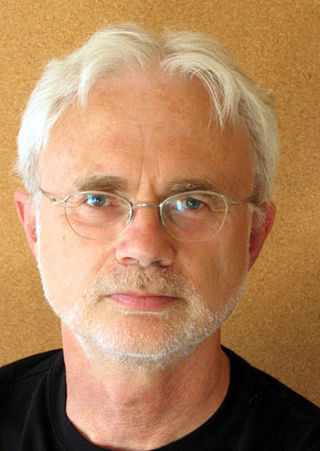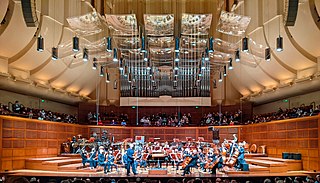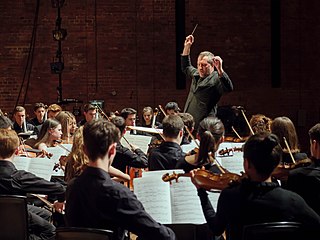Related Research Articles

John Coolidge Adams is an American composer and conductor whose music is rooted in minimalism. Among the most regularly performed composers of contemporary classical music, he is particularly noted for his operas, which are often centered around recent historical events. Apart from opera, his oeuvre includes orchestral, concertante, vocal, choral, chamber, electroacoustic and piano music.
A scherzo, in western classical music, is a short composition – sometimes a movement from a larger work such as a symphony or a sonata. The precise definition has varied over the years, but scherzo often refers to a movement that replaces the minuet as the third movement in a four-movement work, such as a symphony, sonata, or string quartet. The term can also refer to a fast-moving humorous composition that may or may not be part of a larger work.

The San Francisco Symphony (SFS), founded in 1911, is an American orchestra based in San Francisco, California. Since 1980 the orchestra has been resident at the Louise M. Davies Symphony Hall in the city's Hayes Valley neighborhood. The San Francisco Symphony Youth Orchestra and the San Francisco Symphony Chorus (1972) are part of the organization. Michael Tilson Thomas became the orchestra's music director in 1995, and concluded his tenure in 2020 when Esa-Pekka Salonen took over the position.
Robert Wilfred Levick Simpson was an English composer, as well as a long-serving BBC producer and broadcaster.

Michael Tilson Thomas is an American conductor, pianist and composer. He is Artistic Director Laureate of the New World Symphony, an American orchestral academy based in Miami Beach, Florida, Music Director Laureate of the San Francisco Symphony, and Conductor Laureate of the London Symphony Orchestra.

Esa-Pekka Salonen is a Finnish orchestral conductor and composer. He is principal conductor and artistic advisor of the Philharmonia Orchestra in London, conductor laureate of the Los Angeles Philharmonic, and music director of the San Francisco Symphony.

Thomas Joseph Edmund Adès is a British composer, pianist and conductor. Five compositions by Adès received votes in the 2017 Classic Voice poll of the greatest works of art music since 2000: The Tempest (2004), Violin Concerto (2005), Tevot (2007), In Seven Days (2008), and Polaris (2010).

Ludwig van Beethoven's late string quartets are:

The Grosse Fuge, Op. 133, is a single-movement composition for string quartet by Ludwig van Beethoven. An immense double fugue, it was universally condemned by contemporary music critics. A reviewer writing for the Allgemeine musikalische Zeitung in 1826 described the fugue as "incomprehensible, like Chinese" and "a confusion of Babel". However, critical opinion of the work has risen steadily since the early 20th century and it is now considered among Beethoven's greatest achievements. Igor Stravinsky described it as "an absolutely contemporary piece of music that will be contemporary forever."

Nathaniel Stookey is an American composer and musician.

Yuja Wang is a Chinese classical pianist. She was born in Beijing, began studying piano there at age six, and went on to study at the Central Conservatory of Music in Beijing and the Curtis Institute of Music in Philadelphia. By the age of 21, she was already an internationally recognized concert pianist, giving recitals around the world. She has a recording contract with Deutsche Grammophon. Wang tours internationally and has received critical praise for her performances. Yuja Wang lives in New York City.

The San Francisco Symphony Youth Orchestra (SFSYO) is the youth orchestra of the San Francisco Symphony. The SFSYO performs an annual concert series and has made several recordings. The orchestra rehearses in Louise M. Davies Symphony Hall, directed by Daniel Stewart.

Samuel Adams is an American composer. He was born in San Francisco, California. He is a recipient of a 2019 Guggenheim Fellowship.
My Father Knew Charles Ives is an orchestral triptych by the American composer John Adams. The work was commissioned by the San Francisco Symphony. It was first performed by the San Francisco Symphony under the direction of Michael Tilson Thomas at the Louise M. Davies Symphony Hall on April 30, 2003.
The B-Sides is a symphony in five movements for electronica and orchestra by the American composer Mason Bates. The work was commissioned by the San Francisco Symphony and conductor Michael Tilson Thomas, with support from the Ralph I. Dorfman Commissioning Fund. It was premiered May 20, 2009 at the Louise M. Davies Symphony Hall in San Francisco, with Michael Tilson Thomas leading the San Francisco Symphony.
The Symphony is an orchestral composition in four movements by the American composer Christopher Theofanidis. It was commissioned by the Atlanta Symphony Orchestra, which premiered the work under the conductor Robert Spano in April 2009. The piece is dedicated to Robert Spano "in admiration and friendship."
I Still Play is a set of variations composed in 2017 for solo piano by the American composer John Adams lasting approximately five and a half minutes. The work was composed to celebrate the retirement of Robert Hurwitz, the longtime president of Nonesuch Records. It was first performed by the pianist Jeremy Denk at the Brooklyn Academy of Music on April 1, 2017. Adams has described the sound of the piece as "Satie meets Bill Evans." The composer later explained the title of the work in an interview with The Mercury News, remarking, "I'd organized a concert in [Robert's] honor at the Brooklyn Academy of Music and asked about 10 of the composers he'd worked with to write short pieces. I'd overheard someone talking to Bob – they said, 'I didn't know you played the piano.' And Bob said 'Yes, I still play.' So I called my piece 'I Still Play.'"

Gabriella Smith is an American composer from Berkeley, California.
References
- 1 2 3 4 5 Adams, John (2012). Absolute Jest for String Quartet and Orchestra. Retrieved July 1, 2016.
- 1 2 Kosman, Joshua (March 17, 2012). "S.F. Symphony review: John Adams' 'Absolute Jest'". San Francisco Chronicle . Retrieved July 1, 2016.
- 1 2 Swed, Mark (March 16, 2012). "Music review: John Adams' 'Absolute Jest' in San Francisco". Los Angeles Times . Retrieved July 1, 2016.
- ↑ "John Adams Mines Beethoven's Mind". NPR. November 10, 2015. Retrieved July 1, 2016.
{{cite journal}}: Cite journal requires|journal=(help) - ↑ Scheinin, Richard (March 16, 2012). "Review: John Adams' 'Absolute Jest' gets world premiere, led by Tilson Thomas, at American Mavericks". San Jose Mercury News . Retrieved July 1, 2016.
- 1 2 Huizenga, Tom (November 6, 2015). "CD Reviews: John Adams's musical jokes". The Washington Post . Retrieved July 1, 2016.
- 1 2 Gill, Andy (24 July 2015). "Michael Tilson Thomas, San Francisco Symphony, John Adams: Absolute Jest, Grand Pianola Music - album review" . The Independent . Archived from the original on 2015-12-25. Retrieved July 1, 2016.
- ↑ Simpson, Eric C. (October 20, 2014). "John Adams teams with Yale Philharmonia, Brentano Quartet". New York Classical Review. Retrieved July 1, 2016.
- ↑ MacKinney, Lisa (November 19, 2015). "John Adams: Absolute Jest (San Francisco Symphony)". Limelight . Retrieved July 1, 2016.
- ↑ Kosman, Joshua (August 6, 2015). "CD review: John Adams, 'Absolute Jest'". San Francisco Chronicle . Retrieved July 1, 2016.
- 1 2 Clements, Andrew (29 July 2015). "Adams: Absolute Jest; Grand Pianola Music CD review – musically serious but still enormous fun". The Guardian . Retrieved July 1, 2016.
- 1 2 Clark, Philip (September 2015). "ADAMS Absolute Jest. Grand Pianola Music". Gramophone . Retrieved July 1, 2016.
- ↑ Fairman, Richard (September 11, 2015). "Adams: Absolute Jest — review". Financial Times . Retrieved July 1, 2016.
- ↑ Dervan, Michael (September 11, 2015). "John Adams: Absolute Jest – Album Review". The Irish Times . Retrieved July 1, 2016.